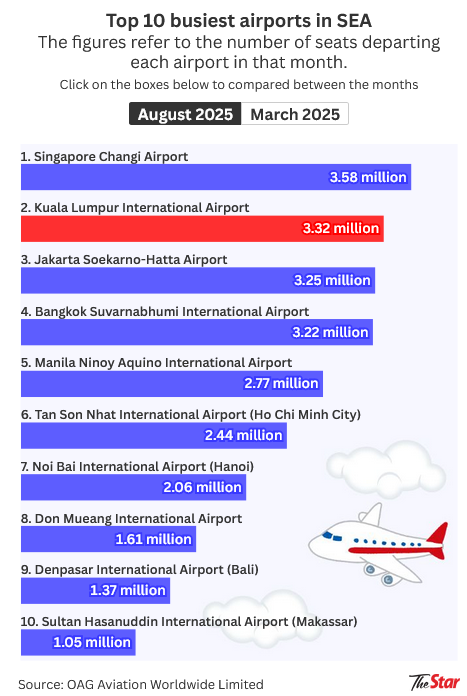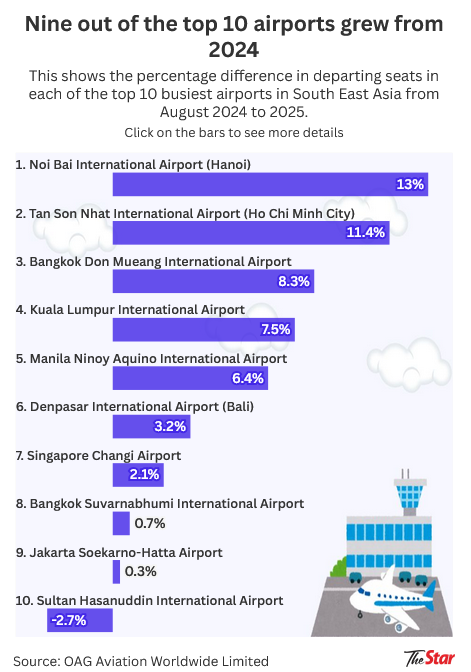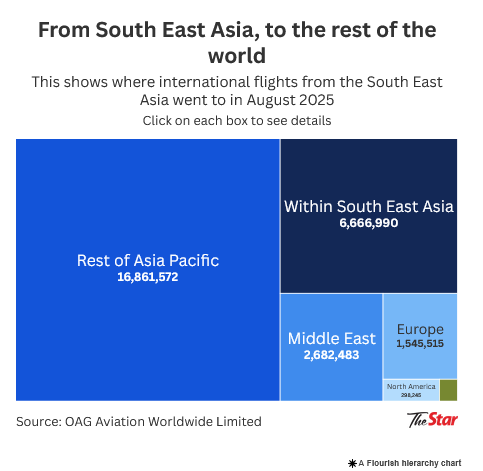September 9, 2025
PETALING JAYA – The Kuala Lumpur International Airport (KLIA) is now the second busiest airport in South East Asia, soaring from the fourth spot six months ago.
This is after KLIA recorded a 10% spike in the number of seats departing the airport between March and August this year.
New airlines taking off, more flight routes and visa-free travel for Chinese and Indian tourists were among the reasons for the rise in rankings, Malaysia Airports Holdings Bhd (MAHB) told The Star.
Last month, the KLIA, with its bustling Terminals 1 and 2, recorded 3.32 million departing seats – a jump from March when it was ranked at the fourth spot in the region with 3.02 million seats.
Sitting at the top spot in August was the Changi Airport in Singapore, which handled 3.58 million departing seats.
Such is based on numbers from OAG Aviation, a global travel data provider headquartered in Britain.
Below shows the top 10 busiest airports in South East Asia.

GRAPHICS PROVIDED BY THE STAR
Spreading our wings
With more airlines operating at the KLIA, Malaysia is now connected to more places.
The KLIA now connects to 117 international destinations, an increase from 105 last year.
“The number of airlines operating at KLIA has also grown – from 59 last year to 66 this year,” said MAHB managing director Datuk Mohd Izani Ghani in an interview.
One of the additional airlines is British Airways which resumed operations in KLIA in April after a five-year pause.
Other new airlines touching down at the KLIA are Juneyao Air and Jiangxi Air at Terminal 1, along with Lucky Air, Fits Air, and Hainan Airlines at Terminal 2.
Currently, Terminal 1 serves 52 airlines, while Terminal 2 accommodates 14.
Another reason for the KLIA becoming a busier airport is Malaysia’s relaxed visa requirements for tourists from key markets such as India and China.
“This move has boosted passenger volumes,” said Mohd Izani.
At present, Chinese and Indian nationals can enjoy visa-free travel to Malaysia until Dec 31 next year.
He said ongoing efforts to improve connectivity have also led the KLIA to increasingly become a regional transit hub.
This is a result of new routes being launched by both existing and incoming airlines.
“Local carriers such as Malaysia Airlines and AirAsia continue to expand their network and frequencies, complementing the growth of foreign airlines using KLIA as a regional base.
“Examples include British Airways’ new London route and Air India’s Delhi service, which broaden KLIA’s international reach and transit appeal,” he added.
There’s also a growth in China-based airline presence, with increased operations by Chinese carriers such as Lucky Air, Hainan Airlines, and Qingdao Airlines.
Aviation expert Assoc Prof Major Dr Mohd Harridon Mohamed Suffian said a notable example of local airlines spreading their wings was the Malaysia Airlines flight from KLIA to the Paris Charles de Gaulle Airport in France.
“This is a significant comeback as this route was discontinued several years ago.
“But due to feasible financial and economic projections, this route was deemed financially viable,” said Prof Mohd Harridon, who specialises in international foresight (aviation and space) at Universiti Kuala Lumpur’s Business School.
Endau Analytics founder and aviation analyst Shukor Yusof said KLIA’s boost was also due to AirAsia as it provides the most connectivity from Terminal 2.
“AirAsia has been aggressive in opening more destinations from Terminal 2 while Malaysia Airlines has also increased flights to the Indian subcontinent, contributing to the spike,” he said, adding that the KLIA is also popular among non-premium flyers.
KLIA has 4th biggest growth
Among the top 10 busiest airports in Asean countries, the KLIA stands at fourth place when it comes to the growth of its capacity.
It showed a 7.5% rise in the number of departing seats in August this year compared with the same month last year.
The Noi Bai International Airport in Hanoi, Vietnam topped the list with the largest percentage growth, charting a 13% spike in departing seats within the same period.

GRAPHICS PROVIDED BY THE STAR
Most or about 60% of international flights from South East Asian airports head to the rest of Asia Pacific, such as countries like China, India and Japan.
“It remains the largest international market with 16.9 million seats and increased by 4.7% compared with August last year,” said the OAG in its website, explaining the data.
Capacity to Africa grew at the fastest rate in August, increasing by 20.6% compared to last year, but remains a small market with 95,500 seats, read the site.

GRAPHICS PROVIDED BY THE STAR
Soaring even higher
With more travellers passing through KLIA’s boarding gates, it’s important that the facilities at the airport are up to par to cater to the increased traffic.
Mohd Izani said improvements are underway to elevate the facilities and infrastructure to create better passenger experience and operational efficiency at Terminals 1 and 2.
“Recently, Malaysia Airports announced key upgrades at Terminal 1, backed by an investment of RM30mil.
“These initiatives include revamped public seating to improve passenger comfort, deployment of new trolleys, introduction of family parking bays and improved signages at the Aerotrain station,” he said.
Other upgrades include cultural showcases featuring Penang and Melaka Heritage Walls and the opening of a new orangutan-themed playground at the Kids Zone in the Satellite Building.
Mohd Izani said the KLIA continues to implement or trial various initiatives, such as the Open Belt Bag-Drop system with five mobile check-in counters, as part of its efforts to elevate the passenger journey.
“These enhancements demonstrate Malaysia Airports’ dedication to providing a safe, efficient, and culturally immersive airport environment that accommodates increasing passenger demand while celebrating Malaysia’s rich heritage,” he added.
Prof Mohd Harridon Mohamed Suffian said the KLIA has become a favourable hub due to its conducive environment, especially for efficient flight transfers, shopping and eateries and interconnected lodging for short stays.
“The facilities at Terminal 2 are similar to an extensive shopping complex, with many global brands.
“It shows that our airports are currently enhanced and have evolved to be trade and commercial centres that cater to aviation passengers,” he said.
However, he said the services at KLIA’s check-in and security clearance processes could be improved.
“Some portions of security clearance are currently utilising biometric identification but there are passengers that still prefer the manual check-in process.
“Streamlining the check-in and security clearance processes would increase the On Time Performance value of the airport,” he said.

